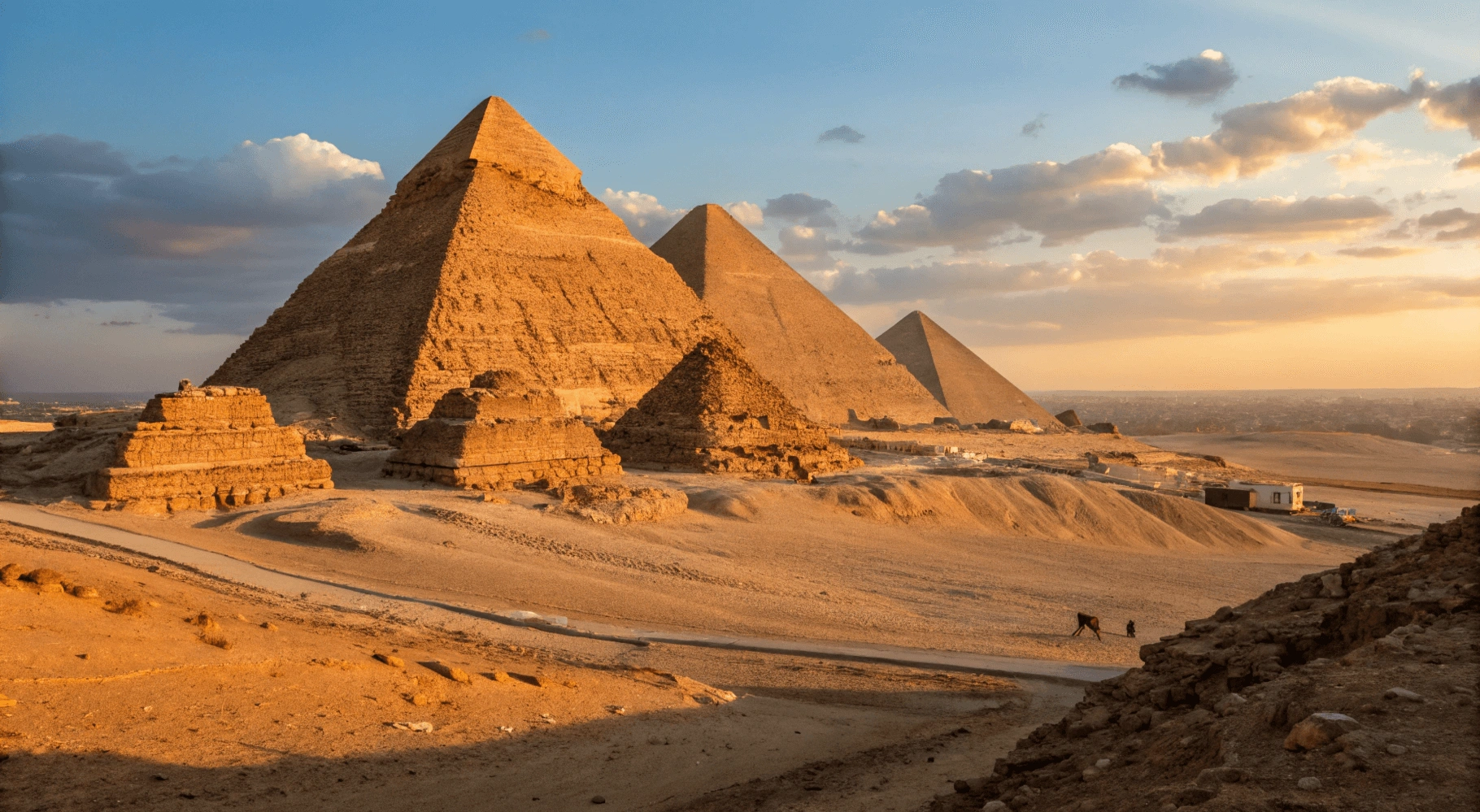Rising majestically from the golden sands of the Giza plateau, the pyramids of Egypt stand as silent sentinels of an ancient world. These monumental structures have captivated humanity’s imagination for millennia, inspiring awe, wonder, and endless questions about how and why they were built. As the last surviving wonder of the ancient world, the Great Pyramid of Giza represents the pinnacle of ancient Egyptian engineering and continues to reveal new secrets even in our modern age.
In this comprehensive guide, you’ll discover the fascinating history of Egypt’s pyramids, explore their most significant sites, understand their construction methods and religious purpose, and learn about the latest archaeological discoveries that continue to reshape our understanding of these magnificent structures. Whether you’re planning a visit to Egypt or simply fascinated by these ancient marvels, this guide will provide you with a deeper appreciation of the pyramid egypt complexes that have defined Egypt’s landscape for over 4,500 years. According to UNESCO, the Pyramids of Giza are part of the “Memphis and its Necropolis” World Heritage Site, recognized for their outstanding universal value and architectural mastery.
Table of Contents
What Are the Egyptian Pyramids?
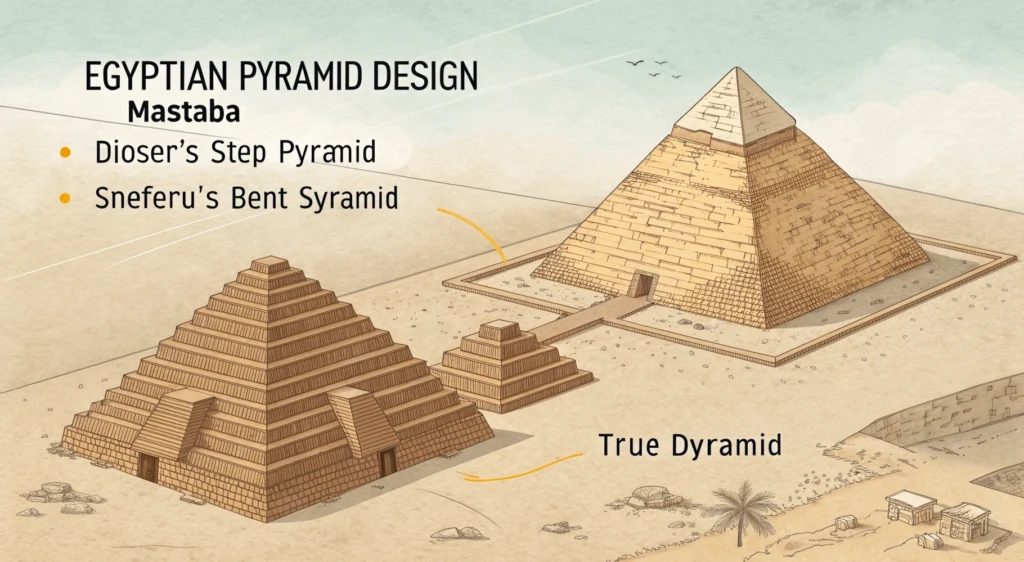
Egyptian pyramids are massive stone monuments constructed primarily during Egypt’s Old and Middle Kingdom periods (approximately 2700-1700 BCE). At their core, pyramids served as elaborate tombs for pharaohs—Egypt’s god-kings—designed to:
- Protect the pharaoh’s body after death
- House the supplies and treasures needed for the afterlife
- Facilitate the ruler’s transformation into a deity, Ancient Egyptian religious beliefs surrounding death and divinity are extensively documented by institutions like the British Museum, which explores the spiritual symbolism behind tomb architecture.
- Serve as eternal monuments to royal power and divine status
The distinctive pyramid egypt shape evolved over centuries:
- Mastabas (3500-2700 BCE): Flat-topped rectangular structures with sloping sides, serving as tombs for early Egyptian elites
- Step Pyramid (c. 2630 BCE): Djoser’s revolutionary design featuring stacked mastabas
- Bent Pyramid (c. 2600 BCE): Sneferu’s transitional design with angles changing midway up
- True Pyramids (c. 2580 BCE onward): The classic smooth-sided shape exemplified by the Great Pyramid of Giza
pyramid egypt fields stretch along the western bank of the Nile, with major concentrations at Giza, Saqqara, Dahshur, Abusir, and Meidum. The western shore symbolized death in Egyptian cosmology, as the sun “died” each evening in the west.
A Journey Through Time: The History of Pyramid Building
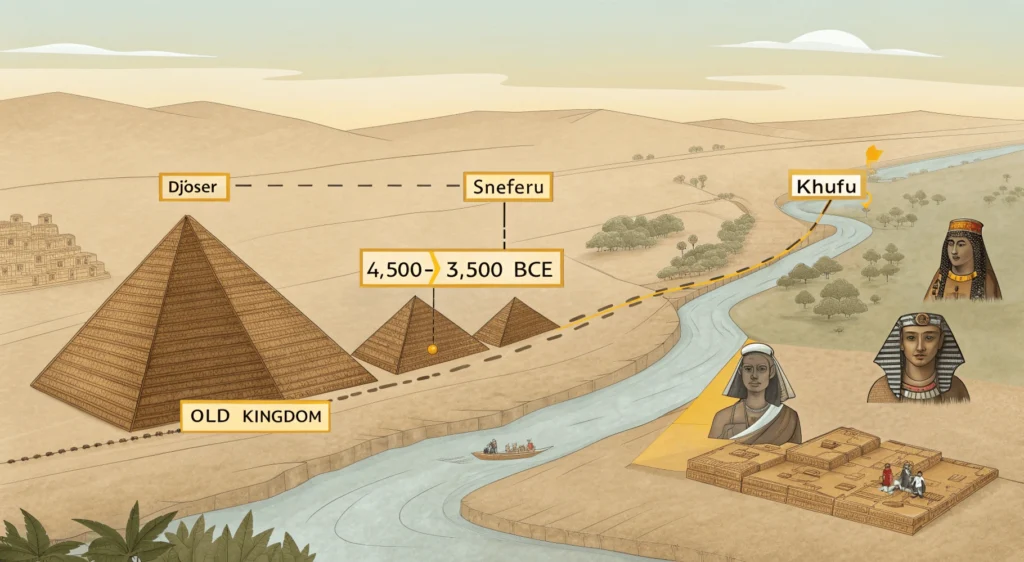
The story of Egypt’s pyramids spans nearly a thousand years, though the most impressive examples were constructed during a relatively brief period of exceptional innovation and resources.
Old Kingdom (2686-2181 BCE): The Golden Age of Pyramids
- Third Dynasty (2686-2613 BCE)
- Pharaoh Djoser and his architect Imhotep revolutionize Egyptian architecture with the Step Pyramid at Saqqara—the world’s first large-scale stone monument
- Fourth Dynasty (2613-2494 BCE)
- Pharaoh Sneferu experiments with pyramid design at Meidum and Dahshur, constructing the Bent pyramid egypt and Red Pyramid
- King Khufu (Cheops) builds the Great pyramid egypt of Giza, the largest of all Egyptian pyramids
- Khafre and Menkaure complete the Giza pyramid egypt complex with their own monuments
- Fifth & Sixth Dynasties (2494-2181 BCE)
- pyramid egypt construction continues but with diminishing size and quality
- Religious texts (pyramid egypt) begin appearing on interior walls
Middle Kingdom (2055-1650 BCE): Revival and Decline
- Smaller, mud-brick pyramids built at sites like Lisht, Dahshur, and Hawara
- Focus shifts to elaborate interior chambers rather than monumental size
- The tradition gradually fades as royalty prefer hidden tombs in the Valley of the Kings
The End of Pyramid Building
By the New Kingdom (1550-1070 BCE), pharaohs abandoned pyramid egypt tombs altogether in favor of concealed rock-cut tombs in the Valley of the Kings near Thebes (modern Luxor). This shift reflected both practical concerns about tomb robbery and changing religious practices. The Metropolitan Museum of Art offers a detailed profile of Djoser and his Step Pyramid, highlighting its revolutionary role in the evolution of monumental architecture.
The Crown Jewels: The Pyramids of Giza
The Giza Plateau holds Egypt’s most iconic pyramid complex: three major pyramids surrounded by smaller queens’ pyramids, mortuary temples, causeways, and the enigmatic Great Sphinx.
The Great Pyramid of Giza (Pyramid of Khufu)
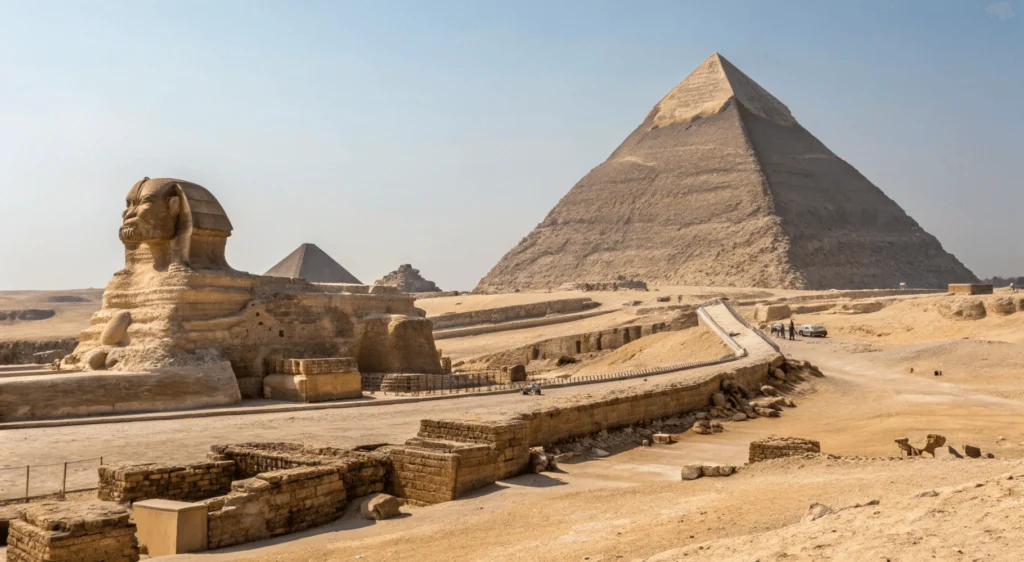
The Great pyramid egypt stands as humanity’s most massive single building project until the modern era.
Key Statistics: The Smithsonian Institution delves into the scale and mystery of the Great Pyramid, offering insights into both historical and modern investigations.
- Original height: 146.5 meters (481 feet)
- Current height: 138.8 meters (455 feet)
- Base length: 230.4 meters (756 feet) per side
- Weight: Estimated 5.9 million tons
- Stone blocks: Approximately 2.3 million
- Average block weight: 2.5 tons
- Construction period: Approximately 20 years (c. 2580-2560 BCE)
Internal Structure: The Great pyramid egypt contains several remarkable interior features:
- The Grand Gallery – A soaring corbeled passage 47 meters long and 8.6 meters high
- The King’s Chamber – Lined entirely with granite, containing a damaged granite sarcophagus
- The Queen’s Chamber – Despite its name, likely not intended for a queen but possibly for a ka statue
- Descending Passage – Leading to an unfinished underground chamber
- Narrow “air shafts” – Extending from both chambers toward the exterior (possibly aligned with stars)
What makes the Great pyramid egypt particularly impressive is its precision. The base is level to within 2.1 cm, and its sides are oriented to the cardinal directions with an accuracy of 0.05 degrees.
The Pyramid of Khafre & The Sphinx
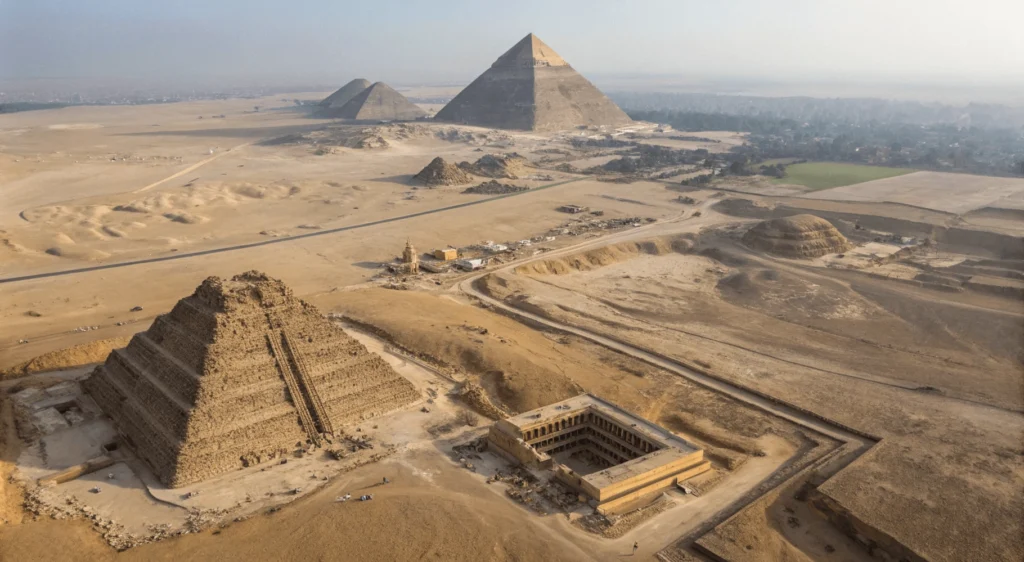
Khafre’s pyramid egyptappears taller than his father Khufu’s due to its position on higher ground and steeper slope angle (53° vs. 51°), though it’s actually slightly smaller.
Key Features:
- Height: 136.4 meters (448 feet) originally
- Base length: 215.3 meters (706 feet) per side
- Distinctive feature: Retains some of its original limestone casing stones at the apex
Connected to Khafre’s pyramid egypt complex is the Great Sphinx, the colossal lion-bodied, human-headed statue that has become an icon of ancient Egypt:
- Length: 73 meters (240 feet)
- Height: 20 meters (66 feet)
- Composition: Carved from a single limestone outcrop
- Face: Believed to represent Pharaoh Khafre
The Sphinx likely served as a symbolic guardian of the Giza plateau and was an integral part of Khafre’s mortuary complex. The mysterious monument has suffered significant erosion over millennia, fueling debates among geologists about its exact age.
The National Research Institute of Astronomy and Geophysics and others continue to study weathering patterns on the Sphinx to better estimate its construction date and environmental history.
The Pyramid of Menkaure
The smallest of Giza’s three main pyramids belongs to Menkaure (Mycerinus), Khafre’s son:
- Original height: 65.5 meters (215 feet)
- Base length: 108.5 meters (356 feet) per side
- Distinctive feature: Lower courses partially cased in expensive Aswan granite
Though more modest in scale, Menkaure’s pyramid complex includes three smaller “satellite” pyramids and an elaborate mortuary temple that contained some of the finest sculptural works of the Old Kingdom.
The Giza Plateau Complex
Beyond the three main pyramids, the Giza plateau features an integrated ceremonial landscape that includes:
- Queens’ pyramids – Smaller pyramids for royal women
- Boat pits – Including one containing the reassembled Khufu solar boat
- Mortuary temples – Where offerings were made to deceased kings
- Causeway remains – Covered corridors that once connected valley temples to mortuary temples
- Workers’ village – Housing the skilled craftsmen who built the monuments
- Mastaba fields – Tombs of nobles and officials positioned near their kings
This entire complex functioned as an elaborate machine for the pharaoh’s eternal life and worship, demonstrating the extraordinary resources Egyptian society dedicated to royal mortuary cults.
Beyond Giza: Other Significant Pyramids
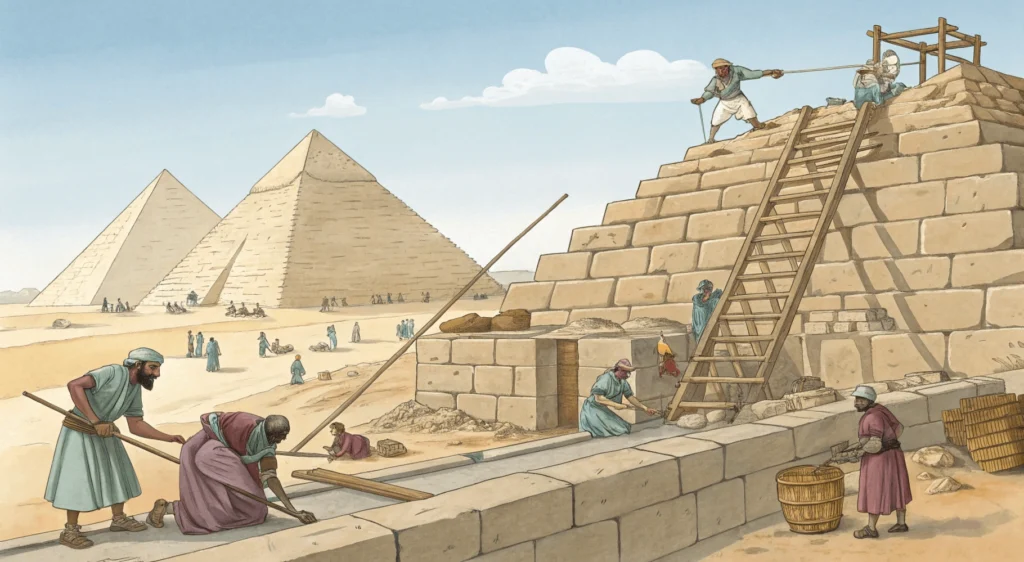
While Giza’s pyramids capture most attention, other sites contain pyramids of tremendous historical and architectural significance.
Saqqara & the Step pyramid egypt of Djoser
Located about 30 km south of Cairo, Saqqara served as the main necropolis for Memphis, Egypt’s ancient capital. Its centerpiece is Djoser’s Step Pyramid:
- Date: c. 2630 BCE
- Height: 62 meters (204 feet)
- Significance: World’s earliest known monumental stone structure
- Design: Six stacked mastabas creating a stepped appearance
- Architect: Imhotep, later deified for his innovations
Saqqara contains numerous other pyramids spanning from the 3rd Dynasty through the Middle Kingdom, making it the longest-used cemetery in ancient Egypt.
Dahshur: The Bent and Red Pyramids of Sneferu
About 40 km south of Cairo, Dahshur contains two critical pyramids built by Khufu’s father, Sneferu:
The Bent Pyramid:
- Date: c. 2600 BCE
- Distinctive feature: Angle changes from 54° to 43° partway up
- Significance: Represents the transition between step and true pyramids
- Unique aspect: Retains most of its smooth limestone casing
The Red Pyramid:
- Date: c. 2590 BCE
- Name: Derived from the reddish hue of its limestone
- Significance: First successful true pyramid egypt with smooth sides
- Height: 104 meters (341 feet)
Other Notable Pyramid Sites
- Meidum: Site of Sneferu’s first pyramid egypt attempt, which partially collapsed in antiquity
- Abusir: Contains pyramids of 5th Dynasty kings, smaller but with elaborate religious texts
- Lisht: Middle Kingdom pyramids of Amenemhat I and Senusret I
- Abu Rawash: Site of Djedefre’s (Khufu’s son) unfinished pyramid
- Hawara: Location of Amenemhat III’s “Labyrinth” pyramid egypt complex
How Were the Pyramids Built? Unraveling the Engineering Marvel
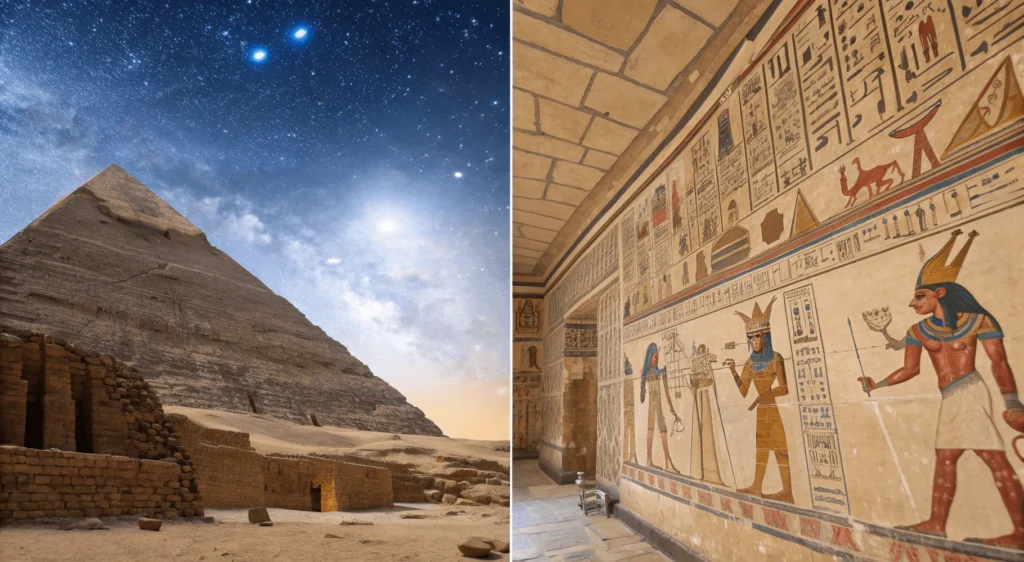
The construction of the pyramids represents one of humanity’s greatest engineering achievements, accomplished without wheels, pulleys, iron tools, or draught animals.
Materials and Sourcing
Limestone:
- Primary building material
- Quarried locally from the Giza plateau for core blocks
- Fine white Tura limestone for outer casing brought from across the Nile
Granite:
- Used for specific structural elements (king’s chamber, sarcophagi)
- Quarried in Aswan, 800 km upriver
- Blocks weighing up to 80 tons transported by boat
Mortar:
- Gypsum-based binding agent used between blocks
- Analysis shows exceptionally high quality, contributing to structural integrity
Transportation and Lifting
Archaeological evidence suggests several techniques working in combination:
Transport methods:
- Wooden sledges pulled over moistened sand (reducing friction by up to 50%), This technique is supported by experimental archaeology and studies like the one published in Physical Review Letters, which confirm that wetting sand significantly reduces friction.
- Barges for river transport of distant materials
- Organized teams using ropes and levers
Ramp theories:
- Straight ramps: Simple but requiring enormous volume
- Spiral ramps: Wrapping around the structure as it rose
- Internal ramps: Using the pyramid’s internal structure (supported by recent evidence)
- Combined systems: Different approaches at different construction phases
Workforce organization:
- Recent evidence from worker settlements indicates:
- Year-round core of skilled craftsmen (not slaves)
- Seasonal labor from farmers during Nile flooding
- Well-organized teams with specialized functions
- Evidence of medical care for injured workers
- Dietary evidence showing protein-rich foods
Dr. Mark Lehner of the Ancient Egypt Research Associates estimates approximately 20,000-30,000 workers at peak construction periods, organized in specialized crews rather than the hundreds of thousands once theorized.
Purpose and Beliefs: Why Were the Pyramids Built?
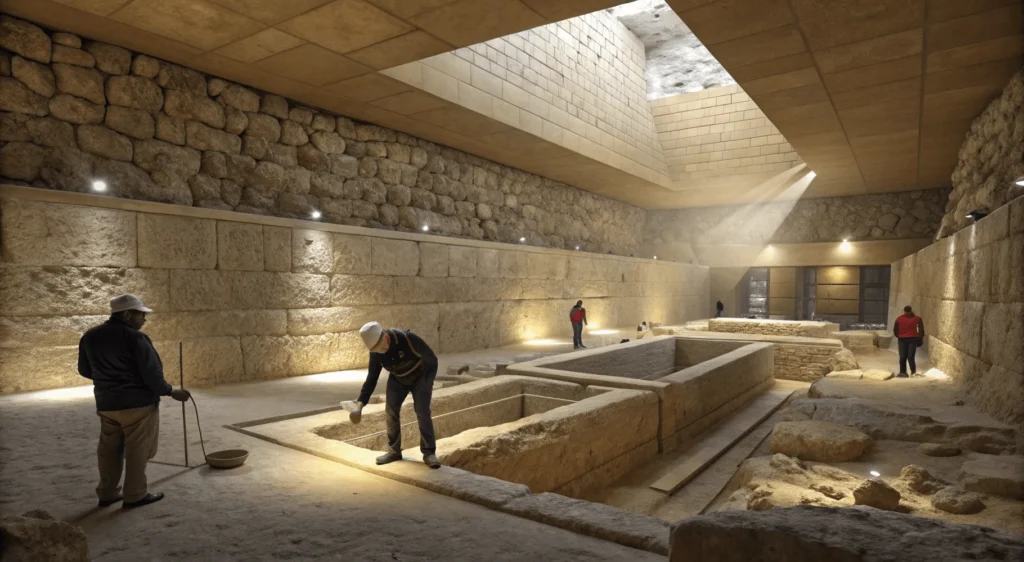
The pyramids’ function was deeply rooted in Egyptian religious and cosmological beliefs.
Path to Eternity
For ancient Egyptians, the pyramid served as a resurrection machine for the pharaoh:
- The pyramid’s shape represented the primordial mound from which creation emerged
- Its points directed toward the circumpolar stars (the “imperishable ones” that never set)
- The structure provided a stairway for the king’s soul to ascend to join the gods
Maintaining Cosmic Order (Ma’at)
Egyptians believed their king maintained cosmic balance (ma’at) between order and chaos. Even after death, the pharaoh needed to:
- Continue receiving offerings through mortuary cults
- Protect Egypt as a divine entity
- Intercede with other gods on behalf of Egypt
The pyramid egypt and its associated temples created permanent infrastructure for these crucial functions.
Solar Connections
Many pyramid features connected directly to Egyptian sun worship:
- Pyramidion caps were often gold-plated to catch the first and last rays of the sun
- The pyramid egypt shape may represent the sun’s rays descending to earth
- Alignment to cardinal directions connected to solar paths
- Adjacent mortuary temples contained solar altars
Inside the Pyramids: Chambers, Passages, and Treasures (or Lack Thereof)

Despite popular imagination picturing treasure-filled interiors, pyramid egypt chambers were relatively spartan by the time of their discovery.
Typical Internal Architecture
Most developed pyramids contained:
- Entrance passageway – Usually on the north face, aligned with circumpolar stars
- One or more chambers – Including the burial chamber with sarcophagus
- Security features – Granite plugs, false passages, and dead ends to confuse robbers
- Serdab chamber – In some pyramids, holding a statue of the deceased king
The Empty Tombs Mystery
Despite elaborate security measures, nearly all pyramids were thoroughly looted in antiquity. Evidence suggests:
- Most robbery occurred within decades or centuries of burial, sometimes during periods of political instability
- Some may have been “inside jobs” by workers familiar with the layout
- Repeated resealing indicates multiple intrusion attempts
Notable Discoveries
While gold and jewels were long gone, archaeologists have found:
- Khufu’s solar boat – A full-sized cedar vessel buried adjacent to the Great Pyramid
- pyramid egypt Texts – Religious spells carved in later pyramids’ chambers
- Remnants of burial equipment – Fragments of sarcophagi, canopic jars, and ritual items
- Workers’ settlements – Providing insights into the builders’ lives
- Foundation deposits – Ritual objects buried at construction commencement
Modern Discoveries & Ongoing Research
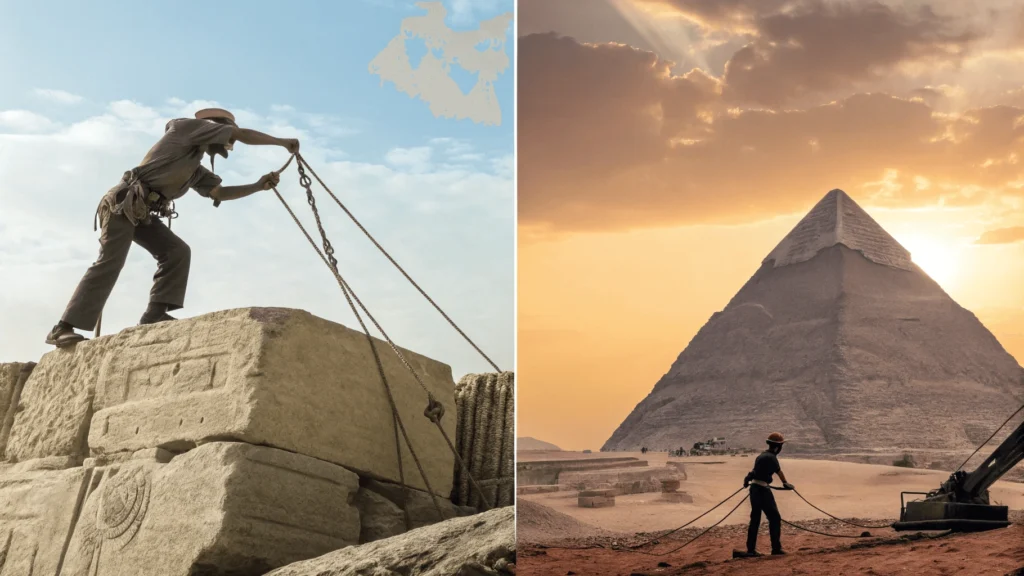
The digital age has revolutionized pyramid egypt research without invasive excavation.
Advanced Scanning Technologies
Recent projects have employed:
- Muon radiography – Using cosmic particles to detect voids within the Great Pyramid
- Thermal scanning – Revealing temperature differences that identify hidden features
- Ground-penetrating radar – Mapping subsurface structures without excavation
- Drone photogrammetry – Creating precise 3D models of pyramid egypt complexes
Recent Major Discoveries
- The “Big Void” (2017) – A previously unknown large chamber above the Grand Gallery in the Great Pyramid, detected by muon scanning
- Hidden corridor (2023) – A 9-meter passage near the main entrance of the Great Pyramid
- Boat pits – Additional solar boat burials identified through remote sensing
- Lost causeway – Mapping of Khufu’s valley temple and causeway path
- Construction ramp evidence – Remains of ramp systems at several sites
Current Research Focus
Today’s Egyptologists are investigating:
- The logistics of pyramid egypt construction through experimental archaeology
- Environmental effects on pyramid egypt preservation
- Digital reconstruction of pyramids’ original appearance
- Sociopolitical factors enabling such massive state projects
- Astronomical alignments and measurement systems
Mysteries, Myths, and Controversies
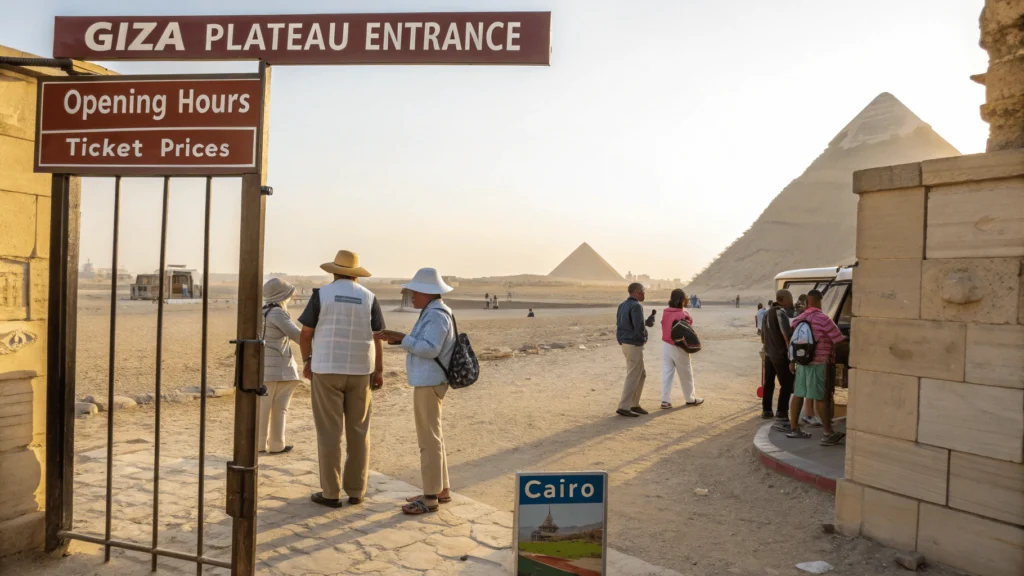
The pyramids have inspired countless theories ranging from scholarly debates to fringe speculation.
Addressing Pseudoarchaeological Claims
While alternative theories about alien construction or lost civilizations capture public imagination, archaeological evidence firmly establishes human construction:
- Tool marks consistent with copper tools of the period
- Evidence of error correction during construction
- Contemporary documentation of building projects
- Evolutionary development from earlier tomb forms
- Evidence of construction camps, tools, and techniques
Genuine Ongoing Questions
Legitimate archaeological mysteries remain:
- Exact methods used to achieve such precise alignments and measurements
- Details of surveying techniques for establishing perfect square bases
- How design knowledge was transmitted between generations
- The specific function of the “air shafts” in the Great Pyramid
- How exactly the largest granite blocks were positioned
- Why certain design decisions were made
Visiting the Pyramids: A Practical Guide
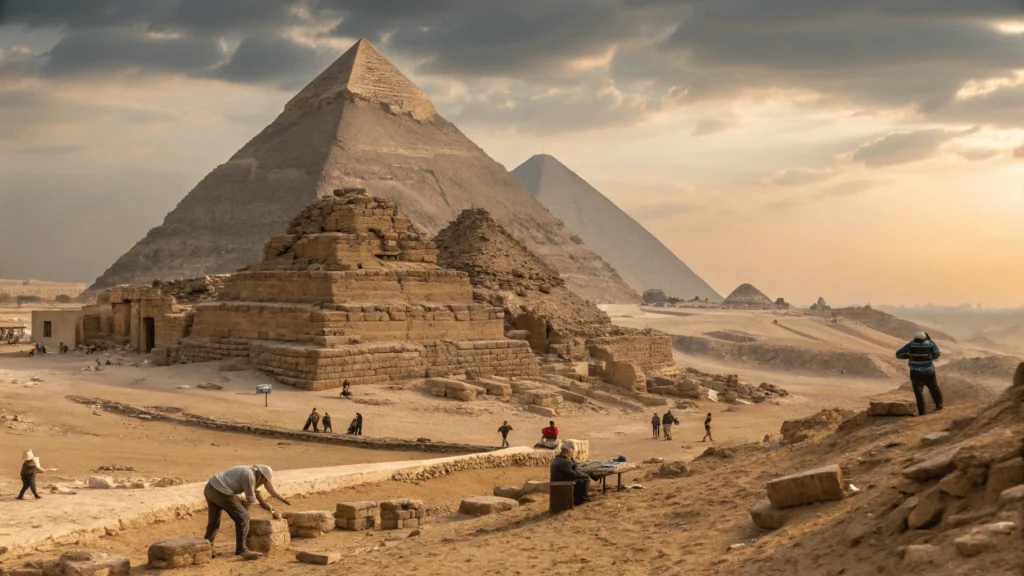
Best Time to Visit
- Peak season: October to April (cooler temperatures, more crowds)
- Low season: May to September (hot but fewer tourists)
- Best hours: Early morning (8-10 AM) or late afternoon (3-5 PM) to avoid midday heat and tour buses
Getting There
- From Cairo center: 30-45 minutes by taxi (negotiate fare in advance)
- Public transport: Take the metro to Giza station, then a taxi to the pyramids
- Organized tours: Available from most Cairo hotels with English-speaking guides
Ticket Information
- Main entrance fee: 240 Egyptian pounds (approximately $15)
- Great pyramid egypt interior: Additional 440 Egyptian pounds (limited daily tickets)
- Khufu Solar Boat Museum: Additional 100 Egyptian pounds
- Opening hours: 8 AM to 5 PM (winter), 8 AM to 6 PM (summer)
- Camera fee: 50 Egyptian pounds for non-phone cameras
Visitor Tips
- Dress appropriately: Loose, light clothing and sturdy walking shoes
- Sun protection: Hat, sunglasses, and sunscreen are essential
- Water: Bring plenty of bottled water
- Guides: Official guides available at entrance (negotiate price beforehand)
- Camel/horse rides: Agree on price and duration before mounting
- Polite refusal: A firm “La shukran” (no thank you) for unwanted services
- Bargaining: Expected for souvenirs and services
Interior Access
Not all pyramids are open to visitors, and those that are rotate to control humidity and damage:
- Great Pyramid: Typically open but requires additional ticket
- Khafre’s Pyramid: Sometimes accessible with separate ticket
- Other sites: Bent Pyramid, Red Pyramid, and Step pyramid egypt interiors sometimes open
Inside, expect:
- Narrow, steep passageways requiring crouching
- Hot, humid conditions
- Minimal interior features (all artifacts are in museums)
- No photography in some areas
The Enduring Legacy of the Pyramids
Cultural Impact
For over 4,500 years, the pyramids have influenced:
- Architecture: From ancient ziggurats to modern skyscrapers
- Literature: Featured in countless works from Herodotus to science fiction
- Art: A persistent motif across cultures and periods
- Popular culture: From movies and games to advertising
Scientific Significance
The pyramids continue to provide insights into:
- Ancient engineering capabilities
- Organizational systems of early complex societies
- Astronomical knowledge
- Mathematical understanding
UNESCO World Heritage Status
The Giza pyramid egypt complex received UNESCO recognition in 1979 as part of “Memphis and its Necropolis” for representing:
- Human creative genius
- Important interchange of human values
- Exceptional testimony to a cultural tradition
- Outstanding example of architectural ensemble
Modern Egyptian Identity
For contemporary Egyptians, the pyramids represent:
- National pride and identity
- Cultural continuity across millennia
- Economic resource through tourism
- Scientific research opportunities

Frequently Asked Questions
How long did it take to build the Great Pyramid?
Approximately 20 years during Khufu’s reign (2589-2566 BCE), based on contemporary records and modern construction analysis.
Were slaves used to build the pyramids?
No. Archaeological evidence from workers’ cemeteries and settlements indicates they were skilled Egyptian laborers, often farmers working during the Nile flood season when agricultural work was impossible. They received payment, medical care, and honorable burial near the pyramids.
What is the oldest pyramid?
The Step pyramid egypt of Djoser at Saqqara, built around 2630 BCE during Egypt’s Third Dynasty.
How did ancient Egyptians cut and move such massive stones?
Limestone was cut using copper saws with abrasive sand, while harder granite was worked with dolerite pounding stones. Stones were moved on wooden sledges over moistened sand, with teams of workers pulling in unison.
Why don’t we build pyramids like this today?
Modern construction prioritizes usable interior space and cost efficiency. The solid-core pyramid egypt design, while structurally sound, represents an impractical use of materials by contemporary standards. However, modern engineering could replicate the achievement with current technology.
Are there pyramids in Egypt beyond those at Giza?
Yes, approximately 118-138 pyramids have been identified across Egypt. Major sites include Saqqara, Dahshur, Abusir, Lisht, Meidum, and Hawara.
How were the pyramids aligned so precisely to the cardinal directions?
Egyptian surveyors likely used stellar observations, particularly circumpolar stars, and shadow measurements to achieve their remarkable precision. The Great Pyramid’s sides align to true north with an accuracy of 0.05 degrees.
What’s inside the Great pyramid egypt today?
The interior contains several corridors and chambers, including the Grand Gallery, King’s Chamber (with an empty granite sarcophagus), Queen’s Chamber, and newly discovered voids identified through muon radiography. All treasures and decorations were removed in antiquity.
Have archaeologists found any intact pyramids?
No pyramid burial chamber has been found completely intact. The closest was the pyramid egypt of Pharaoh Neferefre at Abusir, which contained fragments of his mummy and burial equipment.
Why did Egyptians stop building pyramids?
Several factors contributed: the massive resource requirements, changes in religious practices, increased tomb robbing, and political decentralization. By the New Kingdom (c. 1550 BCE), pharaohs preferred hidden rock-cut tombs in the Valley of the Kings.
Conclusion
The pyramids of Egypt stand as testaments to human ingenuity, organizational capacity, and spiritual devotion. Far from the mystical or extraterrestrial achievements portrayed in pseudoarchaeological literature, these monuments represent the culmination of generations of architectural evolution and the mobilization of enormous resources by a sophisticated ancient society.
What makes the pyramids truly remarkable is not that they contain any particularly advanced technology, but rather the precision, scale, and perfection achieved with relatively simple tools and techniques. They remind us that with sufficient vision, organization, and dedication, humans can accomplish seemingly impossible feats.
As ongoing research continues to unveil new secrets about these ancient structures, our appreciation only deepens. Whether you’re planning to visit these magnificent monuments in person or simply wish to understand them better, the pyramids continue to inspire wonder and respect for one of humanity’s greatest civilizations.
References
- Lehner, M. (2008). The Complete Pyramids: Solving the Ancient Mysteries. Thames & Hudson.
- Hawass, Z. (2006). Mountains of the Pharaohs: The Untold Story of the pyramid egypt Builders. Doubleday.
- Brier, B. & Hobbs, J. (2008). Daily Life of the Ancient Egyptians. Greenwood Press.
- Romer, J. (2007). The Great Pyramid: Ancient Egypt Revisited. Cambridge University Press.
- Tallet, P. (2017). “The Harbor of Khufu on the Red Sea Coast at Wadi al-Jarf.” Near Eastern Archaeology, 80(1).
- Dash, G. (2012). “How the Great pyramid egypt Was Built.” Archaeological Institute of America.
- Supreme Council of Antiquities, Egypt. Official website: egymonuments.gov.eg
- UNESCO World Heritage Centre, “Memphis and its Necropolis” entry.
- ScanPyramids Project research publications (2016-2023).

